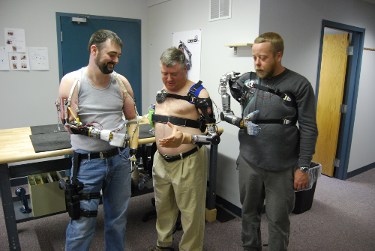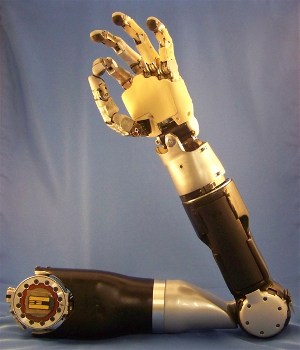 |
| February 14, 2012 | Volume 08 Issue 06 |
Designfax weekly eMagazine
Archives
Partners
Manufacturing Center
Product Spotlight
Modern Applications News
Metalworking Ideas For
Today's Job Shops
Tooling and Production
Strategies for large
metalworking plants
Building high-tech hands for wounded warriors
By Cheryl Pellerin, American Forces Press Service

Users wear and control, without surgery, an advanced prosthetic arm developed under the Defense Advanced Research Projects Agency's Revolutionizing Prosthetics program in 2007. [Photo courtesy: DARPA]
Top scientists and technologists are working with the Defense Advanced Research Projects Agency (DARPA) to give arms and hands back to warriors who lose them in battle.
Army Col. (Dr.) Geoffrey Ling, the DARPA program manager, talked about the program Nov. 19, 2011, to a TEDx Pentagon audience. TEDx Pentagon is a military-focused speaker series.
"When you lose the arm anywhere along its course, you also lose the hand," Ling said. And this hand is truly remarkable – it is the most complex biological tool that exists in nature today."
Even at the finest hospitals in America today, the solution to a missing hand usually is a hook, Ling said, "because making a hand is thought to be impossible."
"But is it?" he asked. Not if you work at DARPA, he said.
Ling said that during his first deployment to Afghanistan in 2003, he was frustrated by being able to help patients survive, but not to completely restore them to health, especially if they had lost limbs, eyesight, or brain function.
When Ling returned from Afghanistan, he was invited to join DARPA. "And let me tell you, it is a magical place," he said. "The leaders there are visionaries. They exhort us daily to challenge what is commonly held to be impossible and instead look at it as possible – and if so, make it probable."
DARPA officials put out a challenge, he said: Make us a hand that looks like a hand, works like a hand, and has the performance characteristics of a hand – and that lets the wearer control it naturally, with the brain.
"Most of the engineers thought we were crazy," he said. "That's good; it means we're on the right track. But a number of them were crazy enough to come work with us."
The challenge included an ambitious timetable.
"We have the most worthy patients waiting for it," Ling said he told the scientists, "so you don't have five or 10 or 20 years. You've got two years … to go from idea to making the thing work."
DARPA decided to divide the program into two parts. One group would build the finest mechanical arm they could. The second would build an arm-hand combination controlled by the brain.
"To get that interface, from brain control to body to arm, that's a little tough," Ling said he told the second group. "So we'll give you four years."
Today, the agency's Revolutionizing Prosthetics program is entering its fifth year, and nearly $150 million is committed to improving the entire upper-limb prosthetic system, including sockets and control software.
By 2008, DEKA Integrated Solutions Corp. had built two generations of a "strap-and-go" arm-hand system that users could wear and control without surgery. Six users helped them assess the prototypes in clinical studies, and clinical and take-home trial subjects logged more than 3,000 hours of use on the second-generation DEKA arm. Trials included 26 participants in a Veterans Affairs Department study that used the DEKA arm in three VA medical centers and the Center for the Intrepid at Brooke Army Medical Center in Fort Sam Houston, Texas.
DEKA plans to finish building its first third-generation system early next year for more VA and Defense Department trials. The arm has 10 powered degrees of motion and six user-selectable hand grips.
It looks like an arm and works like an arm, Ling said, but operates using "local control."
"As you turn, it turns; you lean forward, it comes out; you stand up, it goes back in the same way your arm does," Ling explained. "It has a local mechanical control, so when you grab a cup, for example, your hand conforms around it. … It's fully modular – you lose a hand, we'll give you a hand. You lose your arm below the elbow, we'll give you a hand and a forearm … all the way up to the shoulder. And it's available today."
DEKA is applying for Food and Drug Administration permission to market the arm and is negotiating with commercial partners that eventually will sell the modular systems.

A modular prosthetic limb developed by Defense Advanced Research Projects Agency and scientists at Johns Hopkins University has 17 controlled degrees of motion and eventually will interface with the brain. [Photo courtesy: DARPA]
"It's a wonderful thing – great, great, great," Ling said. "But not nearly good enough, because in the end, that is not full restoration. To do that, we've got to get into the brain."
Over the first four years of the second DARPA effort – to build a hand controlled by the brain – scientists at the Johns Hopkins University Applied Physics Laboratory went through three mechanical designs and gained insight from more than 100 hours of use by six trial participants.
The Modular Prosthetic Limb had 17 controlled degrees of motion at the end of the lab's Phase 2 contract. In June, DARPA awarded a Phase 3 contract so the lab's scientists can finish developing brain implants that could provide near-natural control of the system.
The program inspired the National Institutes of Health to sponsor a challenge for brain control of the advanced arms. Ling said this part of the program has galvanized "every leading neuroscientist in the United States, all the big labs, to be involved in the project. With the help of our friends [at the National Institutes of Health], we have cornered the market."
Together, the scientists have developed "a little brain interface device … half the size of your pinky nail, that lays on the surface of the brain and captures brain signals associated with movement of your arms as you're doing a task," Ling said.
"We've learned how to decode those signals such that it can work an arm," he added. "We've already got primates doing this."
Other partners include the National Institute of Standards and Technology, which has followed program developments to inform standards for medical robots. Several Army representatives act as advisors, and the FDA helps DARPA officials navigate regulatory requirements.
The new hand has five independent, moving fingers and a rotating thumb. Sensors in the fingers let wearers feel what they touch. Vibration sensors in the joints allow them to feel movement. Temperature sensors allow them to feel hot and cold.
Now, Ling said, DARPA and the Johns Hopkins lab are ready to identify patients who will test the new modular arms.
"These are patients who have had spinal-cord injuries, so they are unable to move from the neck down. They have no function of the arms or legs," he said. "Well, we're going to give them an arm."
DARPA intends to have the Johns Hopkins lab run two clinical sites through 2013 to gain data on brain control of the arm prostheses. The clinical sites are seeking regulatory approval for devices they will implant in patients to decode motor signals that will move the arm and hand.
"What we're going to do is … put the chip in and then couple it up to this remarkable arm," Ling said. "What we expect patients to be able to do is all the activities of daily living, such as eating and the like, but also work a keyboard.
"If they can play Chopin on the piano, let them play Chopin," he continued. "If they can work needlepoint and I give them an iPhone, let them have it. That's in six months. In 18 months, I'm going to give somebody two arms because, in the end, I want these patients to be able to lift themselves and roll around in wheelchairs."
The goal is to gain FDA approval to market the modular prosthetic limbs and to use implantable arrays in others who have lost control of their upper limbs, especially amputees and stroke victims.
"Think about what this technology can do for stroke victims, Parkinson's victims [and] spinal-cord victims, of course," Ling said. The elderly also can benefit, he said.
"Why can't the 90-year-old man go out back and play tennis again?" he asked. "Why can't the 80-year-old woman go to her great-grandson's wedding, not in some stinking wheelchair and a diaper, but go there to dance with her grandson?
"These are all within the realm of possibility," he added. "In fact, they're within the realm of probability."
Published February 2012
Rate this article
View our terms of use and privacy policy
